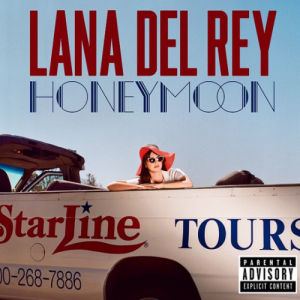Lana Del Rey’s newest album “Honeymoon,” released Sept. 18, is the singer’s most artistic effort yet.
The tone of the album takes listeners on an emotional rollercoaster between the highest of highs and the lowest of lows. Del Rey projects a glamorous façade of ethereality with lyrics like, “Club queen on the downtown scene/Prowling around at night” from the song “Art Deco,” reminding listeners that beauty and agony can be closely intertwined.

Del Rey’s previous album, “Ultraviolence,” focused on dark and gloomy subject material with no respite. In “Honeymoon,” Dey Rey has the same bleak outlook in many songs, but her lyrics are more powerful and better express her autonomy and independence. She wants to let listeners know that she is no longer a passive girl, but a strong woman.
This independence is best exemplified in “High By The Beach” when Del Rey sings, “Lights, camera, acción/I’ll do it on my own/Don’t need your money, money/To get me what I want,” showing that she doesn’t need anyone to baby her.
This independence is even more apparent when looking at the songwriting credits on the album. Rick Nowels is the only person credited besides Del Rey, compared to “Ultraviolence,” where more than six other people were given songwriting credit. Del Rey’s original lyrics are provocative and otherworldly, and it’s surprising that this is the first album that she has primarily written alone because the lyrics are excellent.
This is also the first album where Del Rey has recited a poem, and it is very aurally appealing, though slightly unusual. “Burnt Norton,” originally by T.S. Eliot, is hauntingly beautiful, but seems out of place in the middle of the album. It would have worked better at the beginning of the album as a prelude, but is still a nice respite from her usual lyrics about partying and fame.
Del Rey is at her best when she pulls all of her past experience from old albums together in “Religion,” which draws on the heavy production of “Born to Die,” the swelling strings of “Paradise,” and the evocative vocals of “Ultraviolence.”
In “Religion” she sings that, “It was never about the money or the drugs/For you, there’s only love.” This noirish longing for lost love is apparent in the rest of the album as well, though “Religion” isn’t as fervently sung as other songs and can occasionally sound lethargic rather than impassioned.
Many of the songs on “Honeymoon” are focused on the past, and Del Rey sings about her regrets about previous lovers in a well-executed soporific manner, tapping into the same themes that she did on “Ultraviolence” with great success.
A standout song is the regretful “God Knows I Tried.” With calm guitar strumming, a slow tempo, and slightly manipulated vocals, Del Rey sings lines like, “Sometimes I wake up in the morning to red, blue, and yellow skies/It’s so crazy I could drink it like tequila sunrise.” “God Knows I Tried” is a truly haunting song and a highlight of the album.
“Honeymoon” is an album that will primarily appeal to those who are already fans of Del Rey becauses it draws on many production techniques that she used in previous releases. Most of the songs on the album are not radio friendly, but they are excellent nonetheless.


















